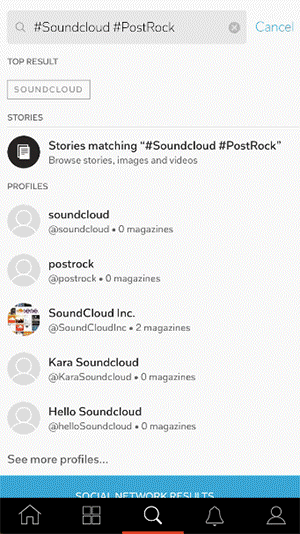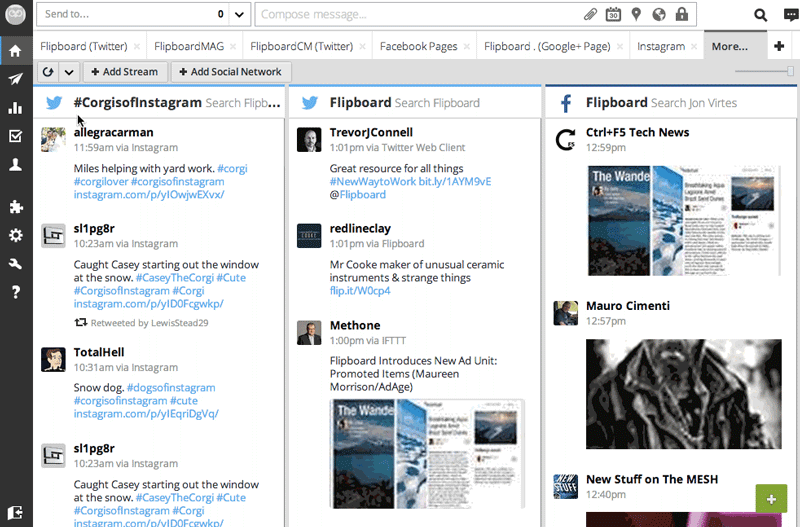The # symbol, known as the “pound” or “hash” key on your phone, is now more popularly known across social media as the hashtag. You may have used it to confirm automated instructions with a bank or phone company or in a list of numbers, but in computing, the hashtag is a metadata tag or label for information. A hashtag is a word or phrase with no spacing or punctuation, preceded by the # symbol: #ThisIsAHashtag. When a hashtag is included in a post on Twitter, Facebook or Instagram, it becomes searchable. By tagging your posts, you are able to be found. Conversely, you can find others who are posting similar material. You can either participate in existing hashtag campaigns, chats, games and challenges, or you can make your own. Here are some we enjoy using or tracking:
#FlipboardFriday, the Flipboard Club’s weekly call for recommended magazines.
#FlipTeam, an inside look at what it’s like to work at Flipboard.
#MagsWeLove, for magazines you love reading on Flipboard.
#MyMagazine, to tell us who you are and what your magazine vision is all about.
To find other popular hashtags, you can check what is Trending on Twitter or the Explore section on Instagram. Before you dive in, it’s always good to see what other people are posting within the context of the tag or if there’s a desired format. Some companies have done this without research and faced criticism for it. Before you create a hashtag on your own, you’ll want to check if anyone’s used it before with a simple Google search. To make your own hashtag, simply start using it on Twitter, Facebook or Instagram. It can be used in context of a sentence or tacked on at the end. It makes no difference if the words are capitalized or not when it comes to searchability, except when it comes to readability. For example: #ThisRidiculousTweet is easier to parse than #thisridiculoustweet. Hashtags don’t work the same way on Flipboard, but you can still search for and flip through any social media hashtag results. Not only are they new sources to flip into your magazines, but also they’re easy to interact with and quickly scannable. For example, if you wanted to find new music for your “post rock” magazine, you could search for #SoundCloud and #PostRock on Flipboard:
For example, if you wanted to find new music for your “post rock” magazine, you could search for #SoundCloud and #PostRock on Flipboard:
 Here are a few more ideas:
Here are a few more ideas:
- On your marketing materials or website, you can use a hashtag for customers to show appreciation for your product or service. Gather these posts into a fan magazine to keep track and acknowledge you received the feedback.
- Document a Twitter conversation and flip relevant materials between entries.
- Engage with other enthusiasts—such as co-workers, people who own a specific breed of dog, those who play together on a sports team or even students in the same class—and contribute to a magazine together.
- Archive a live event with a mixed media magazine of articles about it and social media posts from attendees.
 Please note, an overabundance of hashtag use is considered abusive or spammy behavior. For example, #Typing #Everywhere #Like #This #Can #Get #Tiresome. Spammy hashtags are discouraged. Superficial asks like #Follow4Follow, #Like4Like #TagsForLikes do not generate genuine, organic followings and can attract other spam accounts. Keep in mind that no one owns any single hashtag, which means anyone can participate. A tag can lose popularity and gain it again a year later; it all depends on how many people are using it.
Have hashtags helped you? Tell us about it by tweeting at @FlipboardMag.
~jdlv is curating “toolkit.”
Please note, an overabundance of hashtag use is considered abusive or spammy behavior. For example, #Typing #Everywhere #Like #This #Can #Get #Tiresome. Spammy hashtags are discouraged. Superficial asks like #Follow4Follow, #Like4Like #TagsForLikes do not generate genuine, organic followings and can attract other spam accounts. Keep in mind that no one owns any single hashtag, which means anyone can participate. A tag can lose popularity and gain it again a year later; it all depends on how many people are using it.
Have hashtags helped you? Tell us about it by tweeting at @FlipboardMag.
~jdlv is curating “toolkit.”

